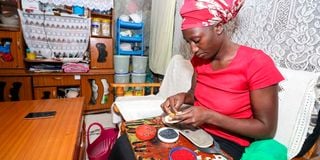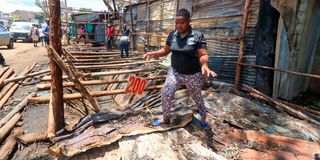I was ready to leave the city for upcountry: Slum women speak after 'maandamano'

Priscilla Aoko at her home in Mathare when she spoke to Nation.Africa on April 3, 2023 regarding the recent Azimio protests. She beads Maasai sandals for Kariokor Market traders in Nairobi.
What you need to know:
- On the first Monday of Azimio protests, Priscilla Aoko's house which was sheltering about 10 children from the Mathare neighbourhood, was teargassed.
- For Agila Khalechi, the protesters broke into her house and attacked her and her children with machetes and stole her electronics.
- Vivian Achieng’ and Christina Valentine, two traders at Karanja in Kibera, found themselves left with nothing but charred remains of their business stalls.
In a viral video that made rounds on social media, Priscilla Aoko, a Mathare resident is seen walking right into the mayhem between anti-riot police and rowdy protesters on the first Thursday of protests (maandamano). Kneeling in between two sides of a charged confrontation, she raised her hands pleading, ‘Amani! Amani!’ (Let peace prevail!)
The anguished mother of four was clearly at the end of her tether.
“I was tired!’’ she exclaims during our interview in her home at Three C area in Mathare, Nairobi. Even though anti-government protests were called off by Azimio La Umoja One Kenya Coalition Leader Raila Odinga the previous day, the tangy tell-tale tear gas smell still hangs in the air of her two-room home.
On March 20, Mr Odinga declared weekly anti-inflation protests. However, the citizen, whose supposed rights were being fought for, has been bearing the brunt of maandamano. Over the past two weeks, women in particular, have counted losses and nursed wounds sustained during the protests.
“I was tired of hiding with my hungry children in the house while being teargassed in a fight that obviously did not involve us. I pleaded with the police to stop firing teargas canisters and the youth to stop throwing stones at the police. If the protest did not stop, I was ready to leave the city for upcountry,” she says.
Ms Aoko is a casual labourer who beads Maasai sandals for Kariokor Market traders in Nairobi. Her daily sustenance of Sh300 from the sale of sandals supplements her husband’s Jua Kali income. She says she was unable to leave Mathare to sell her goods because most matatu operators were too afraid to ply the route.
On the first Monday of the protests, her house which was sheltering about 10 children from the neighbourhood, was teargassed.
“Most of my neighbours brought their children to my house because it is the farthest from the main road where there were heavy exchanges between protesters and police,’’ she explains.
However, that too could not save them from being attacked with teargas canisters.
“When the first canister landed outside our house, the smoke entered into the room and the children started crying. I had to open the door to let in air because it was dark and we were suffocating.’’
As soon as she opened her door, another canister was lodged into her house.
“It happened so fast. I tried to throw it out but it was too hot and I dropped it. Unfortunately, it exploded on the foot of one of my neighbours’ child,’’ she adds.
She doesn't remember what happened afterwards as she lost consciousness and only woke after her neighbours came to her rescue.

Phoebe Awuor narrates her encounters during the recent mass protest at her home in Nairobi's Mathare slum.
Phoebe Awuor, whose child was injured during the incident had left her children in the care of Ms Aoko as she left for work that morning.
Ms Awuor tells Nation.Africa that being the sole breadwinner to her four children, she had no choice but to go to work on that day.
“I was at work when my employer showed me a video clip on her phone of how violent the protest had become in Mathare. I immediately called my neighbour to enquire about the happenings. She told me that my seven-year-old child’s foot had been injured. I was so scared,’’ Ms Awuor reveals.
“I wondered why the police would aim teargas canisters at our homes when the protestors were on the road. I was lucky that one of my neighbours rushed my child to Moi Airbase where he was treated.’’
She has since stopped going to work to nurse her child who she carries to school every day.

Agila Khalechi a resident of Mathare slums in Nairobi points at a repaired wall of her house that was broken into during the recent mass protest.
For Agila Khalechi, the ghosts of maandamano accosted her on the night of the first Thursday of protests. The remnants of protestors that had not been dispersed by police earlier that day, were on a looting rampage at Number 10 area of Mathare.
“They were banging my steel door while I was huddled with my four girls on our bed. I was scared that if they broke through, they would rape my children. I tried screaming for help but nobody came. I thought we would all die,’’ she explains.
They eventually broke the door and attacked Ms Khalechi and her children with machetes and stole all her electronics.
In Kibera, looters masquerading as protesters, stole goods worth hundreds of thousands from women traders before torching their stalls.

Christina Valentine, a resident and trader in Karanja in Nairobi's Kibera slums at the location of her shop that was looted and burned down during the recent Azimio-led mass protest in Kibera.
Vivian Achieng’ and Christina Valentine, two traders at Karanja in Kibera found themselves left with nothing but charred remains of their stalls after the second Monday of maandamano.
“We had taken loans and invested our savings into these businesses and now we have nothing,’’ Ms Achieng’, who tells Nation.Africa that she would make about Sh8,000 from her six stalls in a day.
She claims she lost goods worth Sh320,000.

Vivian Achieng' a resident and trader in Karanja, Kibera slums at the location of her shop which was looted and destroyed during the Azimio protests.
“We usually leave our goods at the stalls overnight and there have never been any incidents. I tried to rescue my goods but the protesters were throwing so many stones, I couldn't stand a chance,’’ she says.
Most women we spoke to were relieved that Mr Odinga had called off the anti-government protests in favour of dialogue with President William Ruto.
Staring at her injured hand, Ms Khalechi wonders: “If there were no protests, would my hand have been injured in such a manner? This is the same hand I use to look for food for my children, now what will I do? ’’
In their own way, the women tried to advocate for peace in their neighbourhoods. Ms Aoko together with women from Number 10 and Three C area in Mathare joined efforts in warning the youth against being used by politicians to disturb the peace.
Nonetheless, they acknowledge that their initiatives are short-term measures and would like the President and Mr Odinga to settle their differences amicably.





